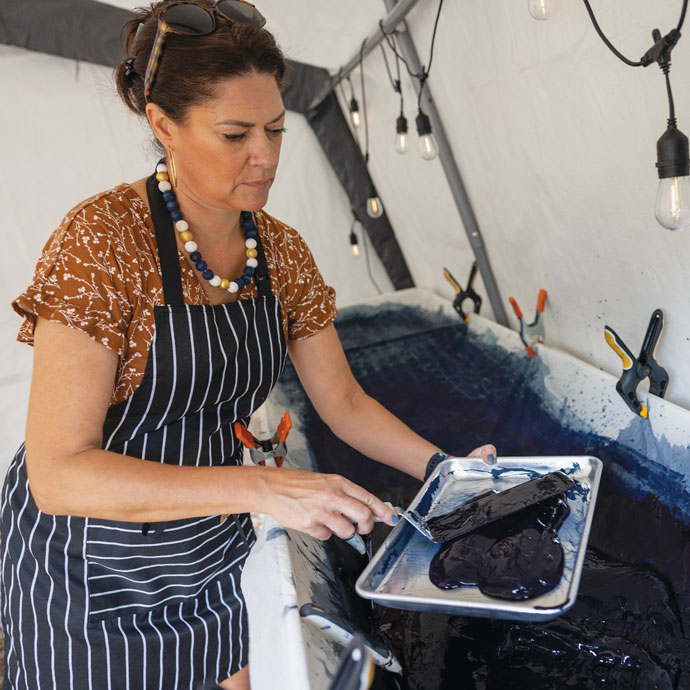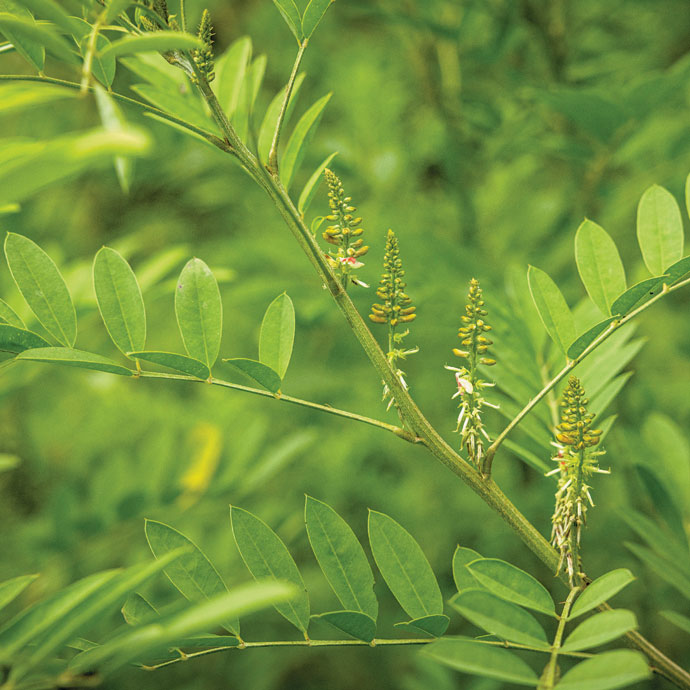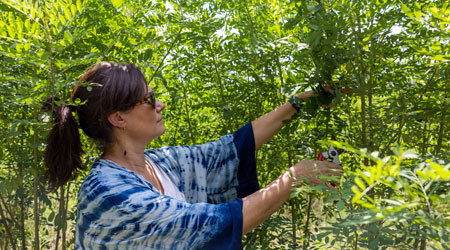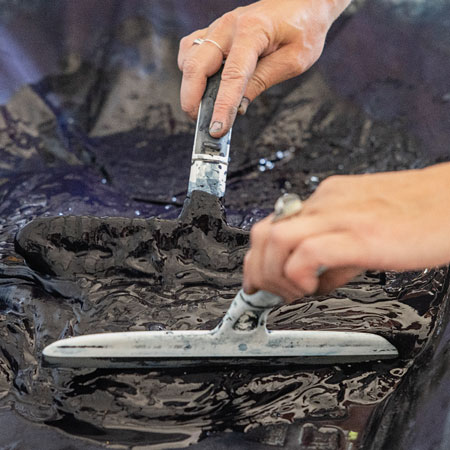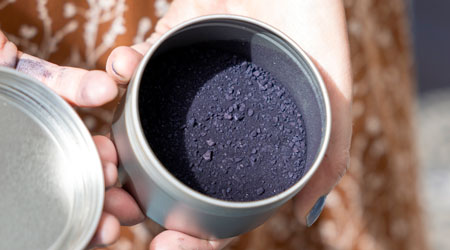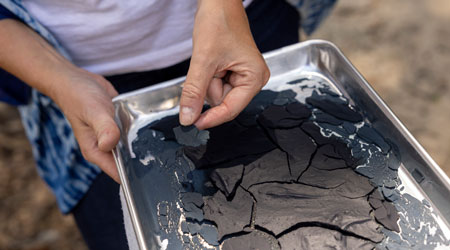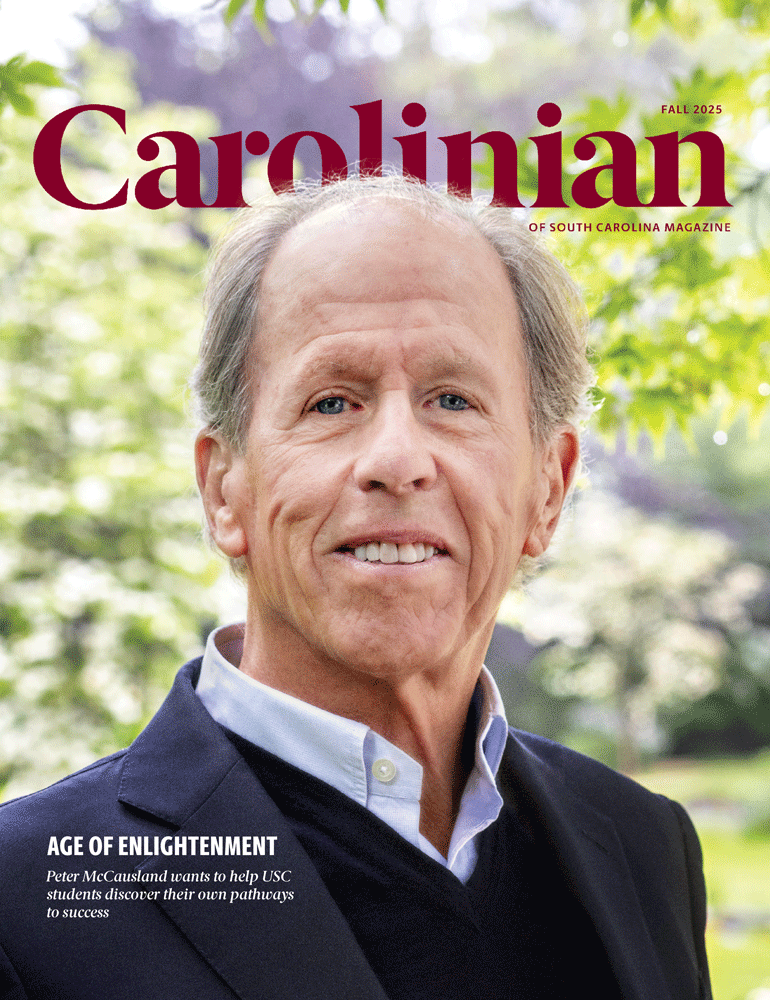Scenes from the process of making indigo, from the plant to the dye to the fabric.
On a Tuesday morning in mid-September, outside a sun-dappled shed along the Ashepoo River in Green Pond, South Carolina, Caroline Harper leans over a cattle trough of plant clippings and water, paying no mind to the spiders and caterpillars that wriggle among the leaves.
She and her assistant, Precious Jennings, are doing something that hasn’t been done commercially in nearly 150 years: processing South Carolina indigo into dye pigment.
If you’re from South Carolina, you may have read about the rich blue dye in your high school textbook — and you should certainly recognize it as the color of the state flag — but you can be forgiven if you don’t know much else about the stuff. Once one of South Carolina’s biggest cash crops, indigo fell out of favor with the advent of synthetic dyes in the late 19th century. And when it disappeared, the knowledge of the pigment’s extraction all but disappeared with it.
Until Harper, ’02 studio art, made it her mission to bring it back. The native of Brittany, France, who came to South Carolina to be a nanny and didn’t start college until she was 25, owns CHI Design Indigo, a Charleston-based business that sells hand-dyed goods and hosts workshops for people who want to dye items themselves.
After several years of research and experimentation — not to mention plenty of blue-stained hands — Harper’s role in the indigo revival is finally turning heads, thanks to write-ups in Southern Living and the Charleston magazine. Her efforts, meanwhile, are increasingly met with curiosity from people intrigued by what she’s doing.
“I get questions all the time,” Harper says. “‘Can I get seeds? Can I grow some? Can I come and harvest, volunteer?’ Indigo is this magical plant that people are just attracted to.”
Nine years ago, shortly after the death of her mother, Harper left a career in graphic design with the dream of getting back to nature. Her journey led her to a silk and indigo farm outside Tokyo, where she took a two-week course on shibori, an ancient Japanese dyeing technique. The process touched her someplace deep.
“My mother loved blue,” she says. “I think about her when I’m working with indigo. And when I do this, I think of her because she was truly the one who gave me that passion for art and style and beauty.”
Of course, Japanese indigo is different than Indigofera suffruticosa, the species
that once flourished in South Carolina’s Lowcountry. The plant is shorter, the leaves
are bigger, and the pigment is extracted through a rice-based fermentation similar
to composting. Still, working with the luminous blue pigment got Harper wondering:
Why not bring South Carolina’s indigo back?
That same year, she and her husband, David, launched CHI. They found land where they could grow a small patch of plants and began learning the tedious process of dye extraction.
Tedious is right. After fermenting in the cattle troughs, excess water must be pumped out to get a slurry, which is collected in buckets and rinsed with vinegar water. The resulting thick blue mud is spread into thin layers on metal pans so it can be dried and ground into a fine powder.
There are also a lot of variables at play. You have to be mindful of the heat, the pH of the water, the freshness of the clippings. A batch needs to steep for two to three days before the water is transformed into a muddy mix of swirling blues and greens. Once that’s complete, lime is added to the mix and oxygen is pumped in to achieve the right molecular structure.
“My husband and I learned everything on our own by researching, talking to people, trial and error,” Harper says. “The growing part was easy, but making pigment took us a few years because we were just trying to figure it out.”
Nearly 300 years ago, in Colonial-era South Carolina, Eliza Lucas Pinckney’s experiments with indigo transformed the area’s agricultural economy. But indigo has, in fact, been used as a dye for thousands of years. In medieval Europe, it earned the nickname “blue gold” because of how expensive it was to import from India.
No one understands that rarity better than Harper. For all the effort she and her assistant put into the harvest each year, the output is minimal. She produces enough powdered dye for her own art, product line and workshops. What’s left to sell to other artists is never more than a few dozen cannisters, which she markets under the name Blue Gold Indigo.
“I think the name has to do with how much work you have to put in to get that blue out of plant. It’s almost like finding gold it’s so hard,” she says. “Everything takes time, from the plant to the pigment, from the pigment to getting on the fiber.”
“I get questions all the time. ‘Can I get seeds? Can I grow some? Can I come and harvest, volunteer?’ Indigo is this magical plant that people are just attracted to.”
But for Harper, there’s no match for the feeling of working with the natural dye.
When she dips a fabric in
the indigo bath, it starts out green and slowly transitions into that famously rich
blue. It’s a dramatic transformation and one that surprises many people the first
time they witness it.
“When I first started doing shibori, I didn't have the local indigo yet, so I would use synthetic,” she says. “That’s not fun. It’s kind of boring, and it’s just not quality. You can tell the color is not there. Working with the plant is a much more of a magical and beautiful process.”
Back at the trough, the billowy sleeves of Harper’s kimono-style top gather at her elbows as she reaches up to clip leafy shoots off an indigo stalk. She dyed the top herself by wrapping the silk tightly around a wide PVC pipe to create a striped pattern, a technique she learned in Japan.
“I think this is my new thing now, the kimonos,” she says. “I like thinking of how the patterns could look pretty and light, because in South Carolina we need everything light. But most of all I like the idea and the creation before it becomes something. I love the designing part of it.”
Design comes naturally to her, but it was also a major focus of her studies at Carolina, and she still draws on that foundation when she’s creating the blankets, scarves and other items she sells through her online shop. What surprised her was her knack for teaching, which didn’t really materialize until she began offering workshops.
“I came from a family of professors and teachers in France, and I never thought I would ever be a teacher,” she says. “And now I love it.”
That newfound enthusiasm for education becomes even more apparent as she talks about the future. Thanks to a recent rural development grant from the U.S. Department of Agriculture, she hopes to expand operations, improve processes and hand off the harvest to other South Carolina farmers, ideally in the next year or two.
If other growers can scale up production, she could scale back to focus on the things she loves most. One potential project would be to create indigo-dyeing kits that could be used during the South Carolina history units offered statewide in fourth and eighth grade.
“It would be a science lesson, art lesson and history lesson all in one little package,” she says. “Students could make a vat with the pigment and dye something for the classroom.”
The history component is critical. Many people get excited about a return to natural dyes and fabrics but bringing back indigo has a complicated legacy. In Colonial America, its production depended on the work of thousands of enslaved laborers working in the fields of South Carolina’s coastal plantations, many of whom came from West African cultures with long traditions of dyeing with Indigo.
“People connect with the history, and they really appreciate that I'm bringing a little bit of that back,” she says. “But I think there's also still a resistance or negativity or a sadness around it. The plant offers opportunities for healing.”
Harper senses that sadness at local markets when she meets members of the Gullah and Geechee communities whose enslaved ancestors harvested and processed the crop on a scale that dwarfs her own efforts. Indigo is part of the fabric of South Carolina’s cultural heritage, she says, but its cultivation isn’t part of her own heritage. Instead, she sees it as something she has borrowed and that she wants to pass on to others. She hopes the beauty of the deep blue dye will transform others the way it has transformed her.
“In my workshops, people come and harvest the plants and make a pot of blue dye and come out with a green scarf that they dye themselves,” she says. “And they always have a big smile because it’s a magical shift when they see it oxidize and turn blue. That’s a magical little moment.”
